Snail Mucin For Skin: Uses, Benefits, & Side Effects
Look for essences, serums, and masks made with snail mucin for a skin-enriching effect.
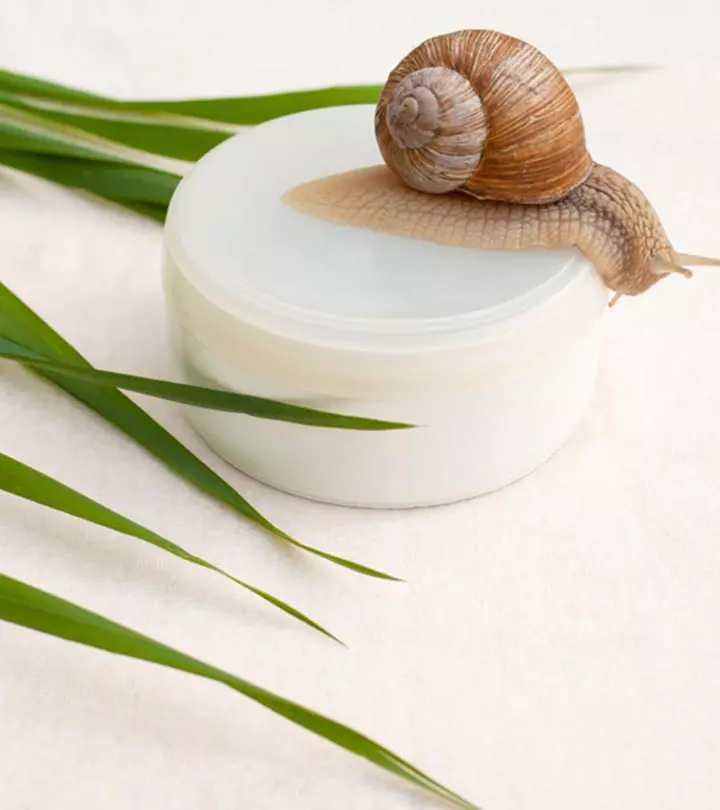
Image: Shutterstock
Everyone is looking for the next great innovation in skin care with multiple benefits. Have you ever thought of using snail mucin for skin care? It is an ingredient that has gained much traction in recent years.
In the world of K-beauty, snail mucin is said to be a beneficial product. And yes, it is derived from snails. While it may sound disgusting, there is a reason why this slime is claimed to give you beautiful skin. It improves skin tone, texture, and moisture. So what is snail mucin? Read this article to learn about snail mucin and how to use it on your skin. Keep reading!
 Know Your Ingredient: Snail Mucin
Know Your Ingredient: Snail MucinA clear, slimy, and viscous liquid secreted by snails.
What Are Its Benefits?
It is claimed to hydrate, heal, and brighten the skin while slowing down skin aging.
Who Can Use It?
Anyone can use snail mucin, especially those with dry, scarred, or pigmented skin.
How Often?
It can be used every day. For sensitive skin, start using it once or twice a week
Caution
Do a 24-hour patch test to check for adverse reactions.
In This Article
Understanding Snail Mucin
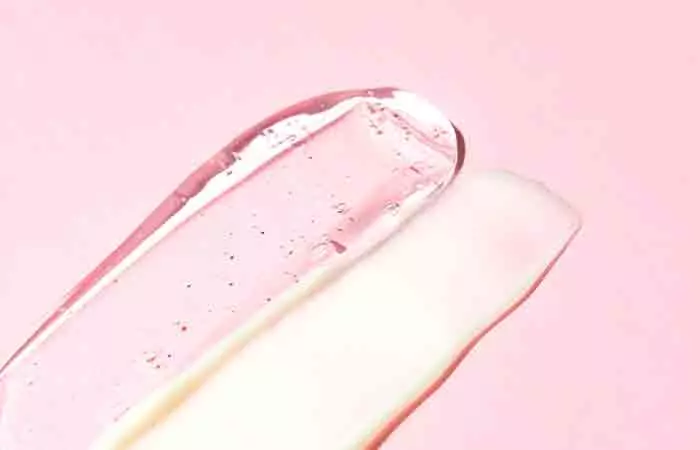
Simply put, snail mucin is the secretion from snails. But, it is not that simple! Here is why.
The garden snail, scientifically known as Cornu aspersum, was discovered by a doctor in the 1960s because of its remarkable ability to heal. He observed that these snails released certain secretions when agitated, which helped them heal quicker (1). Board Certified Dermatologist Dr. Sanusi Umar says, “Snail mucin is a great source of peptides, hyaluronic acid, allantoin, glycolic acid, and antioxidants. Using it either orally or topically on the skin has multiple benefits.”
Most companies in the cosmetics industry breed these snails commercially. To harvest their secretions, batches of snails are agitated using various methods to stimulate production. After that, the snail mucus is collected and filtered to remove any unwanted particles. This process also ensures that the secretion is refined for use in various cosmetic formulations, resulting in the purest and cleanest form of snail mucin (2).
Note that the above is a general production process, and each brand may have different extraction and filtration methods. The process also gives it the name Snail Secretion Filtrate (SSF) that you see listed at the back of most of its products.
 Trivia
TriviaNow, let’s answer the most important question.
How Safe Is Snail Mucin?
With the use of snail mucin for skin having risen over the past few years, there have hardly been any reports of adverse reactions. But, bear in mind that research is still being conducted on this ingredient.
For regular application, snail mucin is perfectly safe. However, you need to use a specific secretion from snails for it to be effective.
Note: If you have sensitive skin or allergies to mollusks, it’s wise to be cautious. Always do a patch test before using it fully. If you are unsure about adding new ingredients to your skincare, it’s best to check with a dermatologist first.
Snails produce different kinds of secretions. One type acts more like a lubricant to help them glide across surfaces without any friction. Another type is released when they are disturbed, which is how most mucin is extracted. The type of snail used is also important. For cosmetic use, brands may use different variations of the garden snail, which is safe for use.
If you are worried about the ethical implications, do not worry. Tons of brands ensure their snail mucin products are cruelty-free. This means that the snails are not harmed in any way while extracting and collecting their mucin.
Thanks to the thriving Korean skin care industry, people all over the world are catching onto their skin care trends – the latest being snail mucin. Here’s how this interesting ingredient gained popularity among skin care enthusiasts.
Key Takeaways
- Snail mucin is the secretion from snails that is said to improve skin texture, tone, and hydration.
- This ingredient also fights free radical damage, prevents skin infections, and aids in the healing of burn wounds.
- However, if you are allergic to snails or mollusks, you should avoid using snail mucus.
The Rise Of Snail Mucin In Skin Care
In recent years, with cutting-edge technologies, better and more efficient extraction methods have come along. Additionally, the formulations of skin care products are more customized now, which is why snail mucin toners, creams, masks, and more have hit the shelves.
Beauty influencers have also contributed to the sudden rise of the ingredient by recommending the product to their followers to help them attain flawless skin.
Using snail mucin has brought along claims of various benefits, which are explored below.
 Trivia
TriviaBenefits Of Using Snail Mucin
Here are some of the most important benefits of snail mucin for your skin:
1. Improves Collagen Production

A study found that snail secretions can stimulate the production of collagen (3). This is great for your skin, as collagen is the protein that helps your skin remain strong and supple. Collagen also maintains skin elasticity and heals injuries. However, further studies are required to confirm its effect.
Board Certified Dermatologist Dr. Yoram Harth says, “Although a few laboratory studies have shown some effects of the snail gel on cell cultures, the clinical studies are sparse. There is still a need to confirm that effects shone in cell culture, enhancing the production of collagen and elastin fibers that are relevant to live humans.”
2. Hydrates The Skin
Well-hydrated skin is a sign of good skin health! Due to many reasons, your skin may lose its ability to maintain optimum hydration. It could be due to age, over-exfoliation, hormonal imbalance, etc.
The problem with dehydrated skin is that it can quickly lose water, a.k.a. transepidermal water loss (TEWL). Snail mucin can combat this because of certain chemicals found in it called glycosaminoglycans (GAGs). They hold great moisturizing benefits as their molecules attract water. Thus, they help moisturize the skin and make it plump (4).
Zee Iheaturu, a lifestyle vlogger, decided to try snail mucin for her skin for seven days and shared her observations on her YouTube channel: “I didn’t see so much of a change, but I did experience that, or I did notice that, my face looks, for the most part, hydrated whenever I applied the product and it would stay [so] all through (i).”
3. Increases Skin Cell Turnover
An analysis of snail mucin’s components found that it contains a small dose of glycolic acid. Glycolic acid is a great ingredient in cell turnover as it breaks down dead skin, allowing fresh skin to develop. In simple terms, it may help with mild exfoliation, leaving your skin smoother and free from dead cells (5).
4. Reduces Pigmentation

The main reason why pigmentation occurs is due to excess melanin developing in some areas of the skin. Melanin is a type of pigment that absorbs the sun’s harmful UV rays to protect the skin. The more melanin present in the skin, the deeper the skin color. Due to different reasons, the body may overproduce it, leading to hyperpigmentation.
Snail mucin was found to have antimelanogenic properties that hinder melanin production. Hence, it may help reduce the appearance of hyperpigmentation (6). According to Board Certified Dermatologist Dr. Sanusi Umar, ”The mucin is also rich in peptides. Peptides and antioxidants help with fading any dark spots on the skin. Add to that the photoprotectivei The property of a substance to be able to provide protection against damage from the sun’s harmful UV radiation. quality of snail mucin and those qualify the secretion as an effective cream to fight hyperpigmentation.” This, coupled with its ability to increase cell turnover, may prove to be immensely effective at doing the job! Here, to enrich yourself, you may also read more about peptides for skin, as they are powerful compounds that help improve skin elasticity, support collagen production, and reduce the appearance of fine lines.
5. Reduces Scarring
When your skin scars, it is due to a lack of collagen that rebuilds the portion of injured skin. If there is less collagen, the skin rebuilds with gaps, leading to pit-like scars. If there is excess collagen, the skin can over-form, leading to a raised bump of skin on the injured area.
Snail mucin can help with your skin’s regeneration ability. It was found to improve the healing of wounds – and even accelerate the process – in a study conducted on rats (7). So if you have a wound, its chemicals will help the bonds within your skin form efficiently. Board Certified Dermatologist Dr. Sanusi Umar adds, “Although snail mucin is best for acne scars and dark spots, it can sometimes be helpful with active acne, too, due to its anti-inflammatory properties. In addition, the acids in it reduce excess oil. The less oil there is clogging the pores, the lower the chance of breaking out.”
Note that reports on existing scarring are minimal, and most studies have been conducted on wounds. However, anecdotal evidence suggests that it is an effective acne treatment as well.
6. Anti-Aging Properties
As you get older, your skin is not able to produce as much collagen and other chemicals that keep it hydrated and looking plump. Due to this, it becomes easier for damage to occur and wrinkles to form.
A study conducted using a cream with 80% snail mucin found that the users noticed a significant difference in the appearance of wrinkles, skin elasticity, dermal density, and skin tightening in 4 weeks (8).
Also, due to its ability to provide hydration to the skin, snail mucin extract may also help prevent premature wrinkles due to dry skin.
Snail mucus has several beauty benefits, but it can also improve your overall skin health. Read on to learn how.
Maintaining Your Skin Health With Snail Mucin
Snail mucin is known for its cosmeceutical benefits, which means it has both pharmaceutical and cosmetic uses. Some of the skin health advantages of this ingredient are:
1. Prevents The Growth Of Bacteria
Snail secretions are a great way to keep your face cleaner and prevent bacteria from growing. Studies have shown that snail mucus contains antibacterial properties (9). This may especially be helpful for healing wounds and lesions.
2. Antioxidant Properties
Oxidative stressi A condition in which an imbalance between oxygen reactive species and its defense system leads to skin cell dysfunction. plays a significant role when it comes to skin damage. Hence, dermatologists usually recommend using antioxidant serums for the skin.
These serums work by scavenging free radicals and preventing them from causing skin damage (10).
Snail mucin is reported to have antioxidant qualities that may also boost its ability for cell regeneration and healing (11).
3. Pharmaceutical Uses
Although more research is needed, snail mucin is currently being studied and tested to be used as surgical glue and for developing better tissue adhesive formulas. Along with this, it has been used in the treatment of burn victims’ wounds, thanks to its regenerative, adhesive, and antimicrobial properties (12).
Surely after reading about the snail mucin benefits, you must be keen on trying it out. Below is a breakdown of adding snail mucin to your daily skin care routine.
How To Use Snail Mucin

Since snail mucin extract comes in a variety of formulations, the key to using it effectively lies in which part of your routine you add it to.
- Essence
This must be used after toner but before any thicker formulations. Gently pat the snail mucin essence onto your skin and let it settle so that it is absorbed completely. Then, go ahead and do the other steps of your routine.
- Serum
Use the snail mucin serum after toning and other water-based treatments (such as glycolic wipes). Like the essence, gently pat it onto your skin and wait for it to get absorbed before continuing with the rest of your routine.
- Cream/ Moisturizer
Note what kind of formulation it is. If it is water-based cream or moisturizer, ensure that you use it before any oil-based products. Otherwise, it will sit on top of the oil layer and not reach your skin.
Oil-based formulations can go on as the last step. This way, you also seal in the other layers and lock in the hydration.
- Masks
You can use snail mucin masks once a week or occasionally, depending on your preference. Be sure to cleanse your face completely and pat it dry before applying the mask.
The above instructions are the general way to apply these formulations. However, for best results, read the label of your product for specific directions for use.
If you are trying to gauge the overall safety of snail mucin before adding it to your skin care regimen, take note of some of its side effects listed below.
Side Effects Of Using Snail Mucin
As mentioned earlier, snail mucin still needs to be studied further. It has no known side effects yet. However, if you have a known allergy to snails or mollusks in general, you should refrain from using snail mucus.
Regardless of whether or not you are allergic to snails, it is recommended to conduct a patch test before application. Apply it to a small portion of your forearm and leave it on for 24 hours. If you do not see any adverse reaction, you may apply it to your face.
Snail mucin on its own has no known reactions with skin care actives. But, some added ingredients could react to another product in your routine. This can cause unwanted effects and reduce the formulation’s overall efficacy. So, always do your research before using a product.
Snail mucin has numerous benefits. However, if you are allergic to it or simply do not wish to apply snail secretions to your skin, check out the next section for some alternatives.
Snail Mucin Alternatives
- Hyaluronic Acid: It can help retain water to hydrate and plump the skin, reducing the appearance of fine lines and wrinkles. It is also found in snail mucin and studies suggest that hyaluronic acid may help minimize UV-induced skin damage and prevent premature skin aging (13),(14).
- Aloe Vera: Research suggests that it may help hydrate the skin, decrease the appearance of fine wrinkles, and have anti-acne benefits (15). Like snail mucin, it is also rich in antioxidants and minimizes skin damage (15).
- Ceramides: Studies suggest that just like snail mucin, they help increase skin hydration and improve barrier function (16).
Infographic: Who Should Use Snail Mucin For Skin Care?
Applying snail slime to your face may sound gross, but it has been one of the most popular components in Korean beauty products for years, thanks to its anti-aging and skin-repairing properties.
In the infographic below, we will provide some helpful information about who should use snail mucin for skin care. Check it out! Illustration: StyleCraze Design Team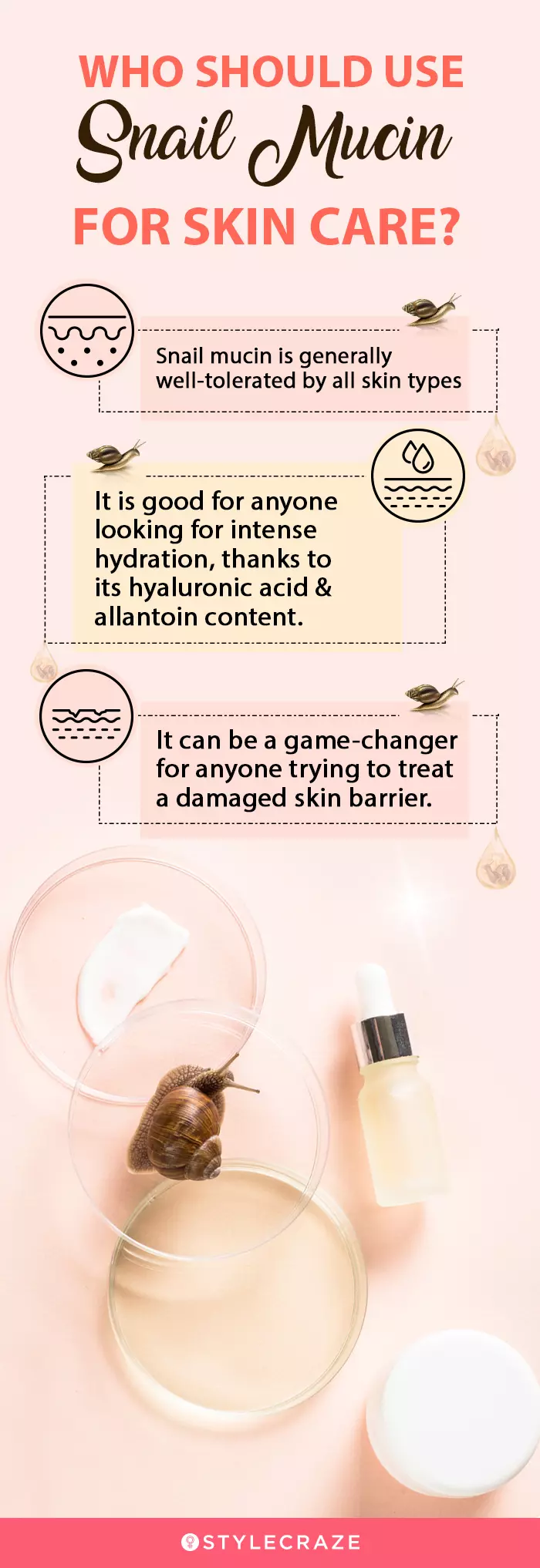
Snail mucin is a beneficial product in the skin care industry. As an ingredient derived from the snail, it might sound disgusting, but it claims to have several beauty benefits. Using snail mucin for skin care may improve the skin texture, tone, and hydration levels. In addition, snail mucin can boost collagen production and increase cell turnover, improving skin elasticity and reducing scarring. You may get snail mucin in various formulations like essences, serums, creams, and masks. Though no side effects are reported yet, you may avoid using it if you are allergic to snails or mollusks.
Frequently Asked Questions
Can you mix vitamin C and snail mucin?
Yes, you can combine vitamin C with snail mucin. Vitamin C boosts collagen production and protects the skin from oxidative stress (17). Snail mucin helps nourish and hydrate the skin (18).
Is snail mucin the same as hyaluronic acid?
No, snail mucin and hyaluronic acid are not the same. Snail mucin is the secretion that comes from snails. Hyaluronic acid is a natural substance produced by the human body. However, snail mucin does contain hyaluronic acid which helps in moisturizing the skin.
Can snail mucin cause whiteheads?
Overuse of snail mucin may clog your pores and cause whiteheads. Ensure that you use a lighter formulation and the right amount to avoid clogging your pores.
Is snail slime poisonous?
No, snail slime is not poisonous. However, topical creams may contain microorganisms that may possibly transmit diseases.
How does snail mucin compare to other hydrating ingredients?
Snail mucin is often compared with hyaluronic acid. They are both great for hydration, but snail mucin goes further. It helps improve skin elasticity and aids healing, thanks to its peptides and antioxidants. This makes snail mucin a more complete option for overall skin health.
Illustration: Snail Mucin For Skin: Uses Benefits & Side Effects
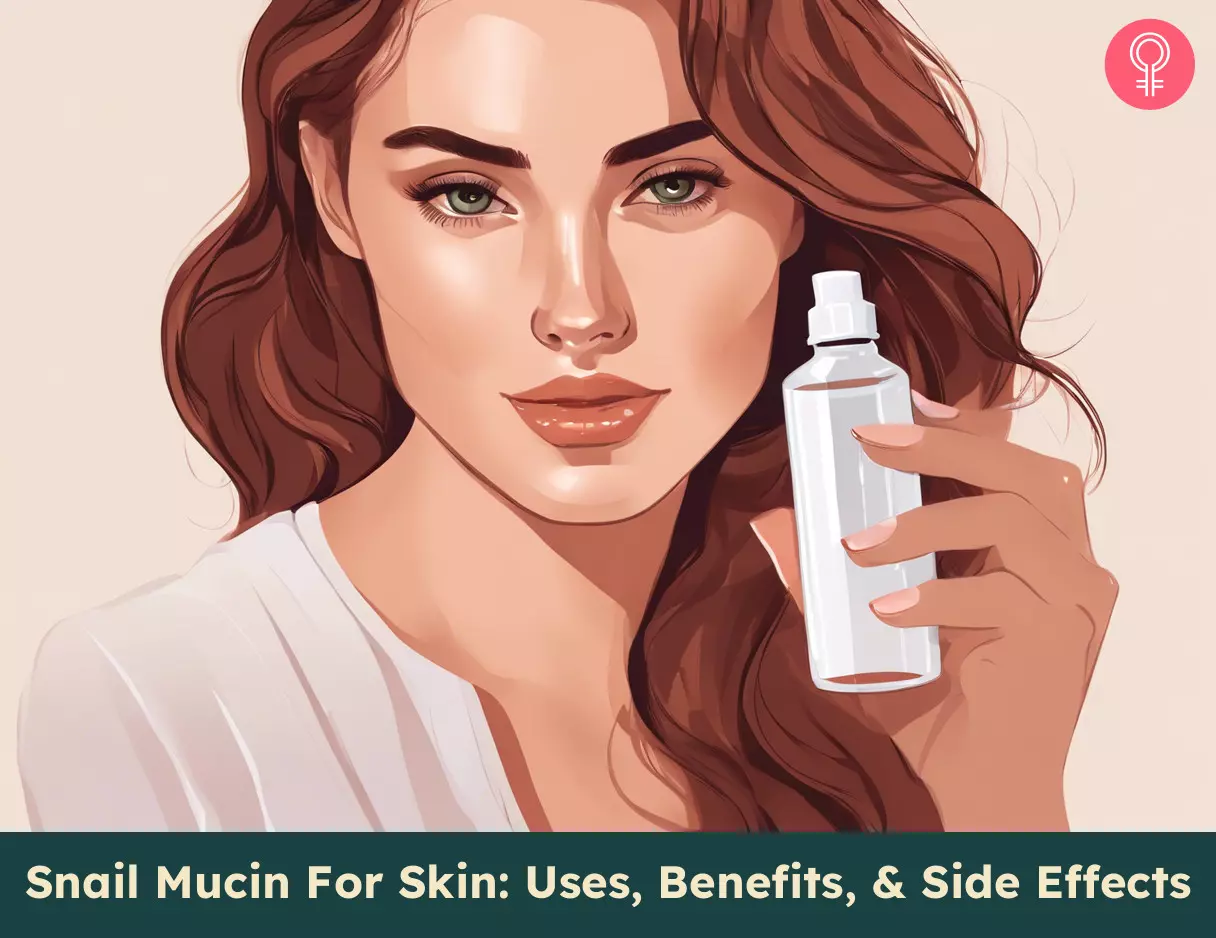
Image: Stable Diffusion/StyleCraze Design Team
Experience the amazing benefits of a snail facial. It might help boost collagen and leave you feeling refreshed and rejuvenated. Watch this insightful video to know more.
Personal Experience: Source
StyleCraze's articles are interwoven with authentic personal narratives that provide depth and resonance to our content. Below are the sources of the personal accounts referenced in this article.
i. I APPLIED SNAIL MUCIN ON MY FACE FOR 7 DAYS & THIS HAPPENED + KOREANS MADE ME DO IT
https://www.youtube.com/watch?v=h_SgMsZF0JQ
References
Articles on StyleCraze are backed by verified information from peer-reviewed and academic research papers, reputed organizations, research institutions, and medical associations to ensure accuracy and relevance. Read our editorial policy to learn more.
- Therapeutic and cosmetic compositions for treatment of skin
https://patents.google.com/patent/US5538740A/en - Helix and Drugs: Snails for Western Health Care From Antiquity to the Present
https://www.ncbi.nlm.nih.gov/pmc/articles/PMC1062150/ - Dosage of Bioactive Molecules in the Nutricosmeceutical Helix aspersa Muller Mucus and Formulation of New Cosmetic Cream with Moisturizing Effect
https://journals.sagepub.com/doi/full/10.1177/1934578X19868606 - Land Snails: The Key to Beauty?
https://nhm.org/stories/land-snails-key-beauty - HelixComplex snail mucus exhibits pro-survival
proliferative and pro-migration effects on mammalian fibroblasts - Helix aspersa maxima mucus exhibits antimelanogenic and antitumoral effects against melanoma cells
https://www.sciencedirect.com/science/article/abs/pii/S0753332217357281 - Application of snail mucin dispersed in detarium gum gel in wound healing
https://academicjournals.org/journal/SRE/article-full-text-pdf/61E1B7112748 - Use of cream containing mucus secreted by snails has an anti-aging effect on skin
https://www.researchgate.net/publication/282744379_Use_of_cream_containing_mucus_secreted_by_snails_has_an_anti-aging_effect_on_skin - Antibacterial activity of snail mucus mucin
https://www.sciencedirect.com/science/article/abs/pii/0300962982901232?via%3Dihub - Oxidative Stress in Aging Human Skin
https://www.ncbi.nlm.nih.gov/pmc/articles/PMC4496685/ - Snail mucus in skin care
https://www.mdedge.com/dermatology/article/223415/aesthetic-dermatology/snail-mucus-skin-care - The efficacy of Helix aspersa Müller extract in the healing of partial thickness burns: A novel treatment for open burn management protocols
https://www.tandfonline.com/doi/abs/10.1080/09546630802582037?journalCode=ijdt20 - Hyaluronic acid: A key molecule in skin aging
https://www.ncbi.nlm.nih.gov/pmc/articles/PMC3583886/ - Snail mucus from the mantle and foot of two land snails Lissachatina fulica and Hemiplecta distincta exhibits different protein profile and biological activity
https://www.ncbi.nlm.nih.gov/pmc/articles/PMC8050916/ - Aloe vera: A short review
https://www.ncbi.nlm.nih.gov/pmc/articles/PMC2763764/ - Skin hydration is significantly increased by a cream formulated to mimic the skin’s own natural moisturizing systems
https://www.ncbi.nlm.nih.gov/pmc/articles/PMC6197824/ - The Roles of Vitamin C in Skin Health
https://www.ncbi.nlm.nih.gov/pmc/articles/PMC5579659/#:~:text=Normal%20skin%20contains%20high%20concentrationsprotection%20against%20UV%2Dinduced%20photodamage - Snail Soothing and Repairing Cream Improves Skin Hydration after Ablative Fractional CO2 Laser: A Split-Face Randomized Double-Blinded Placebo-Controlled Trial
https://www.karger.com/Article/Pdf/515965
Read full bio of Dr. Sonam Jeswani Ramrakhiani
- Dr. Sanusi Umar, MD, FAAD, is a dermatologist who has been practicing for more than 20 years. He is affiliated with multiple hospitals in Manhattan Beach, California, including Torrance Memorial Medical Center and Providence Little Company of Mary Medical Center Torrance. He received his medical degree from University of Maiduguri College of Medical Sciences and is a leader in the removal of AKN (Acne Keloidalis Nuchae).
 Dr. Sanusi Umar, MD, FAAD, is a dermatologist who has been practicing for more than 20 years. He is affiliated with multiple hospitals in Manhattan Beach, California, including Torrance Memorial Medical Center and Providence Little Company of Mary Medical Center Torrance. He received his medical degree from University of Maiduguri College of Medical Sciences and is a leader in the removal of AKN (Acne Keloidalis Nuchae).
Dr. Sanusi Umar, MD, FAAD, is a dermatologist who has been practicing for more than 20 years. He is affiliated with multiple hospitals in Manhattan Beach, California, including Torrance Memorial Medical Center and Providence Little Company of Mary Medical Center Torrance. He received his medical degree from University of Maiduguri College of Medical Sciences and is a leader in the removal of AKN (Acne Keloidalis Nuchae). - Dr. Yoram Harth is a board-certified dermatologist with over three decades of experience in dermatology and aesthetic medicine. He is a member of the American Academy of Dermatology (AAD), former research fellow at the Department of Dermatology, Columbia Presbyterian University in New York, and the author of dozens of scientific publications,
 Dr. Yoram Harth is a board-certified dermatologist with over three decades of experience in dermatology and aesthetic medicine. He is a member of the American Academy of Dermatology (AAD), former research fellow at the Department of Dermatology, Columbia Presbyterian University in New York, and the author of dozens of scientific publications,
Dr. Yoram Harth is a board-certified dermatologist with over three decades of experience in dermatology and aesthetic medicine. He is a member of the American Academy of Dermatology (AAD), former research fellow at the Department of Dermatology, Columbia Presbyterian University in New York, and the author of dozens of scientific publications,
Read full bio of Arshiya Syeda
Read full bio of Ramona Sinha
Read full bio of Monomita Chakraborty







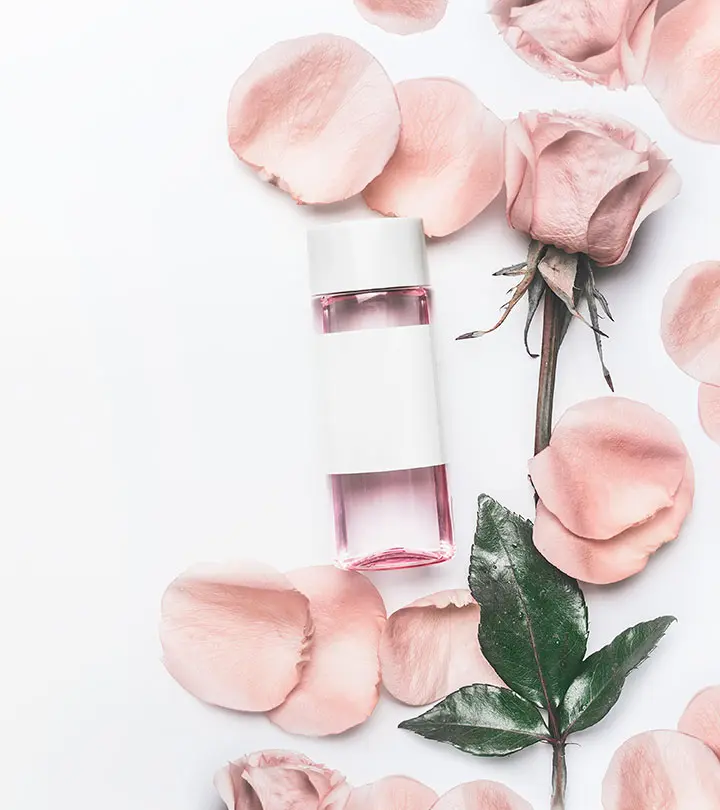
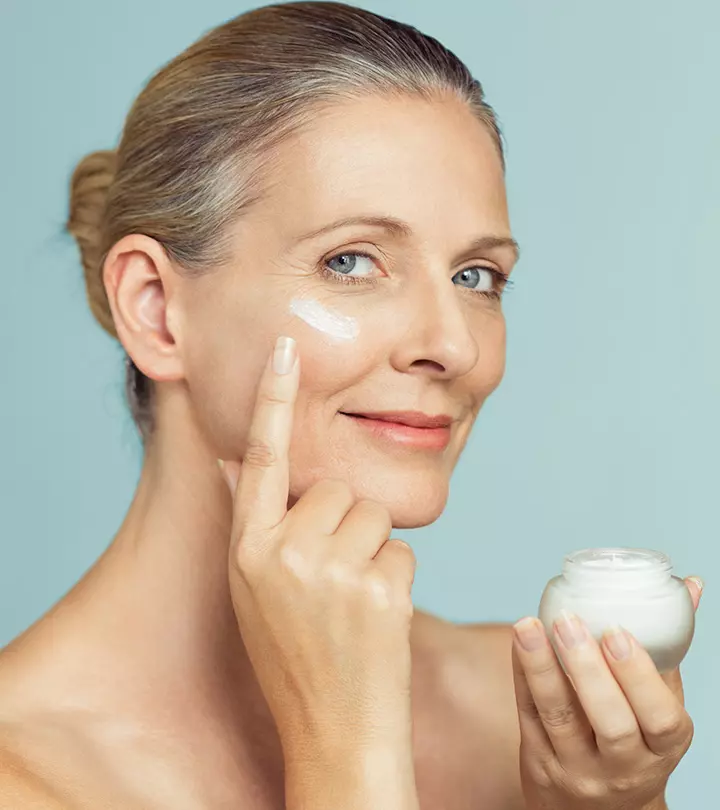

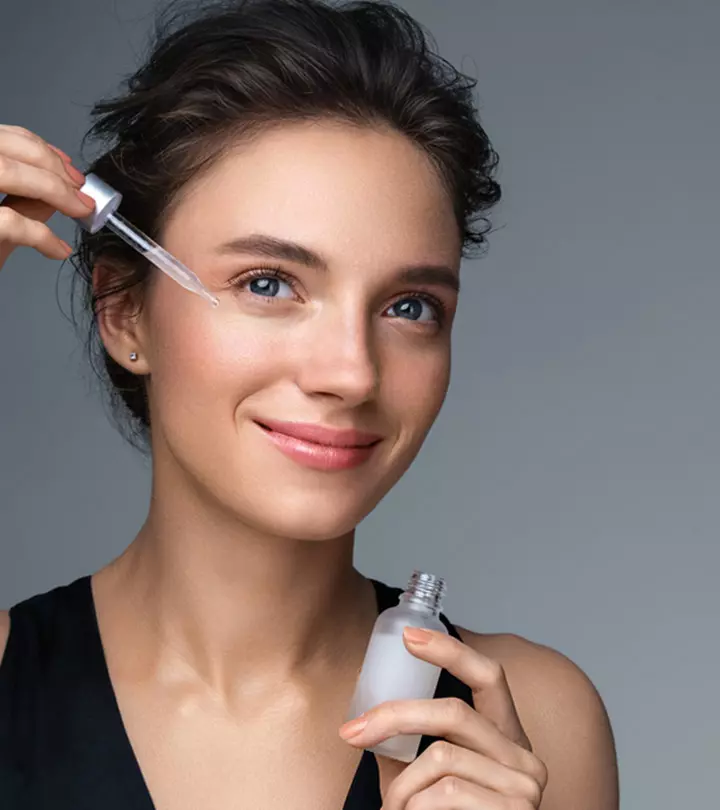
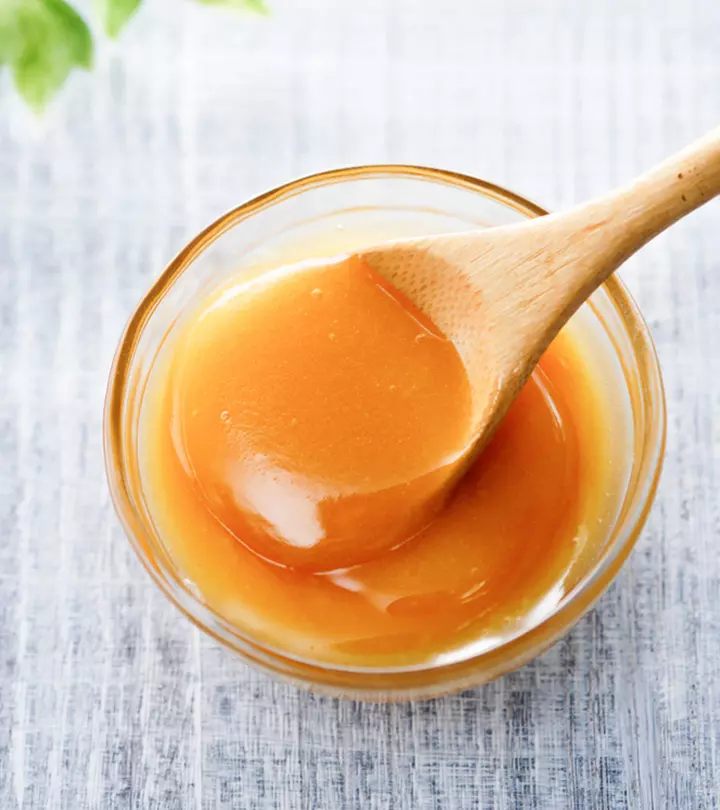

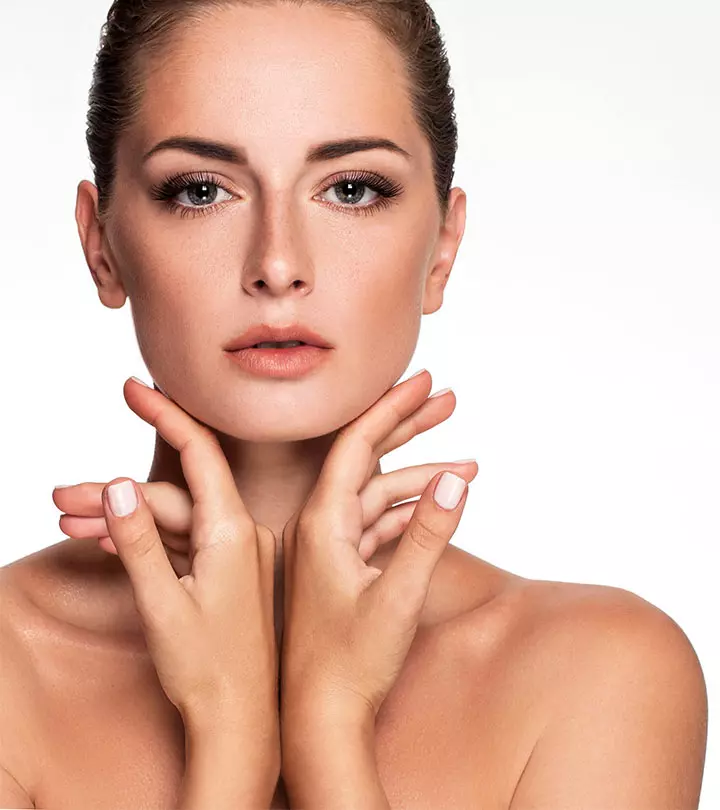
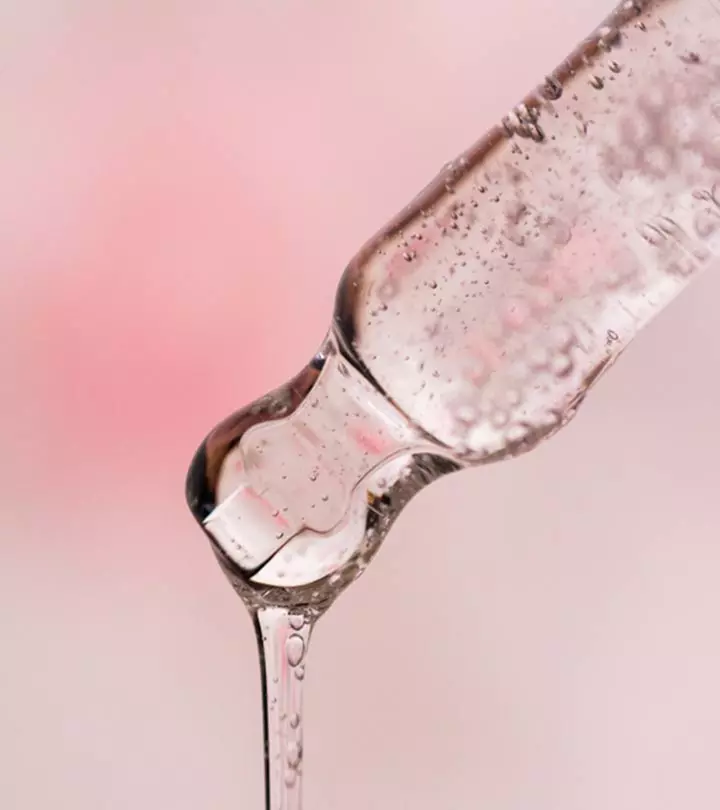

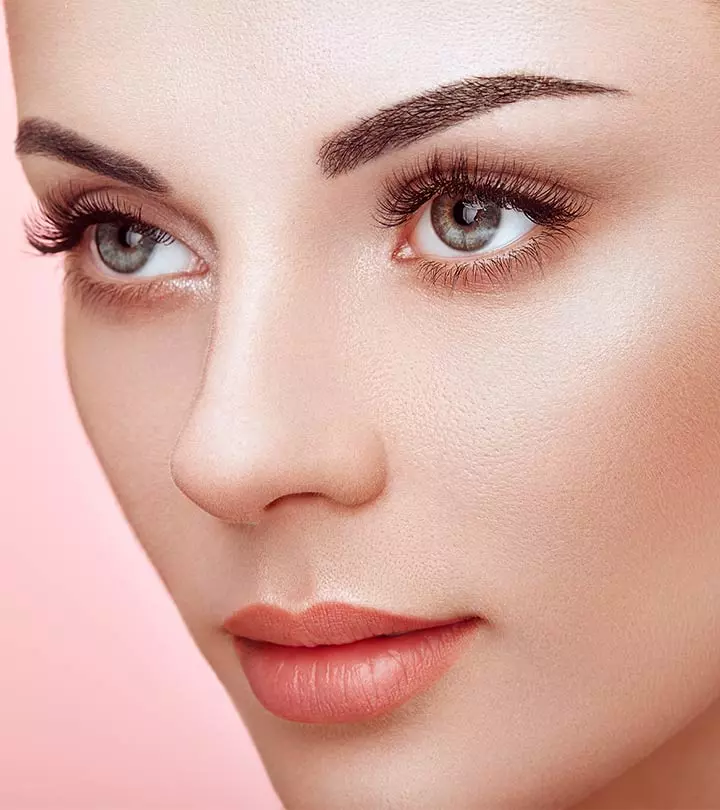
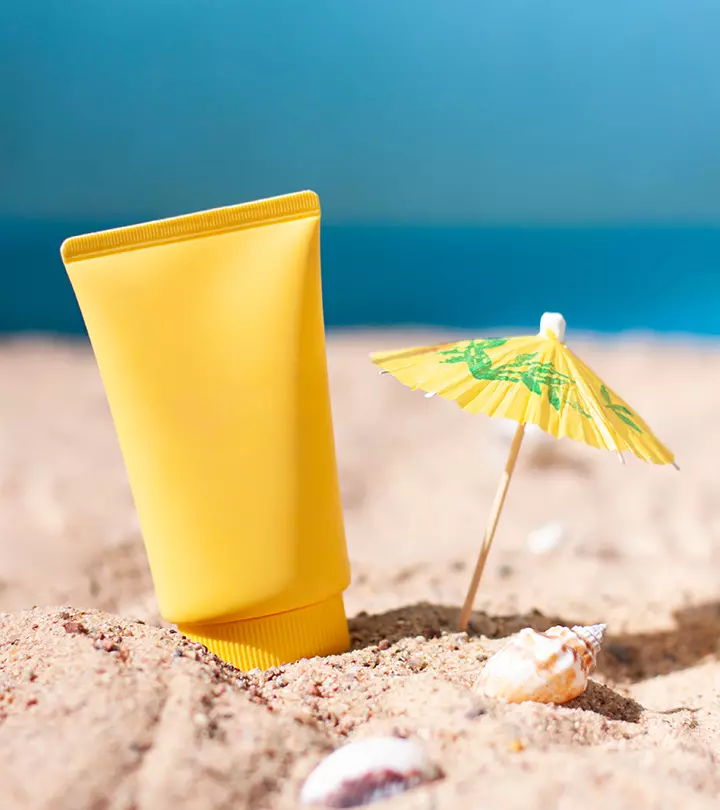

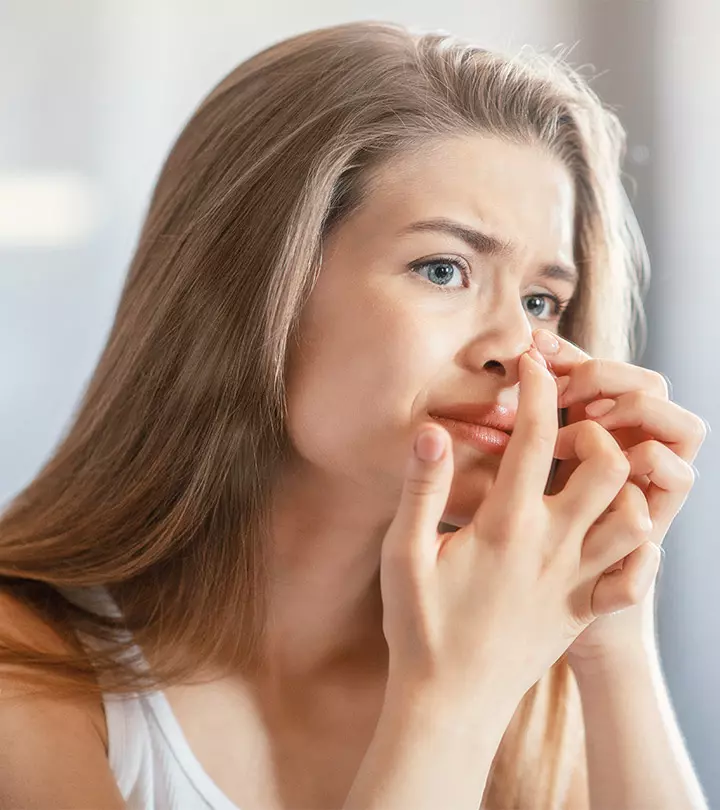
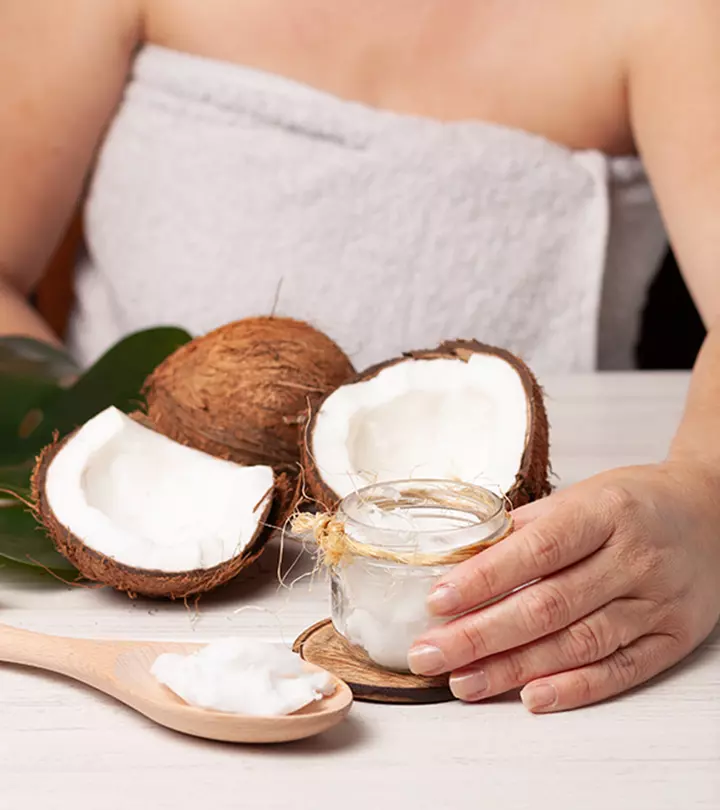
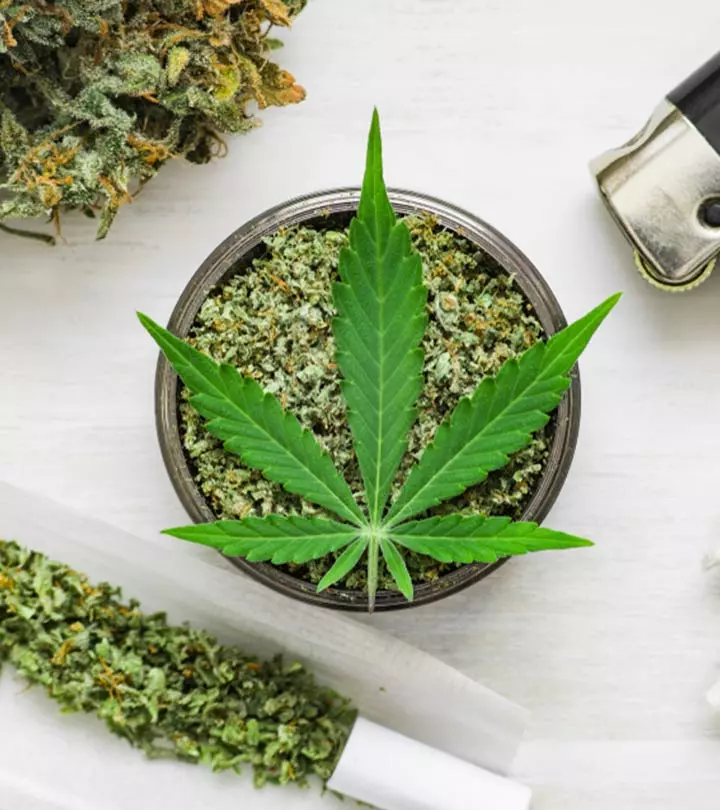
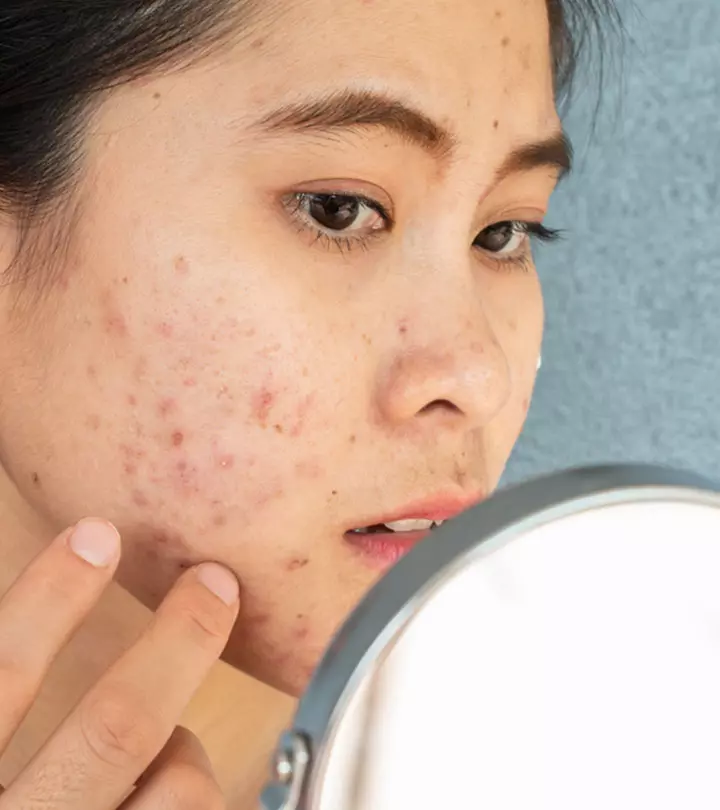
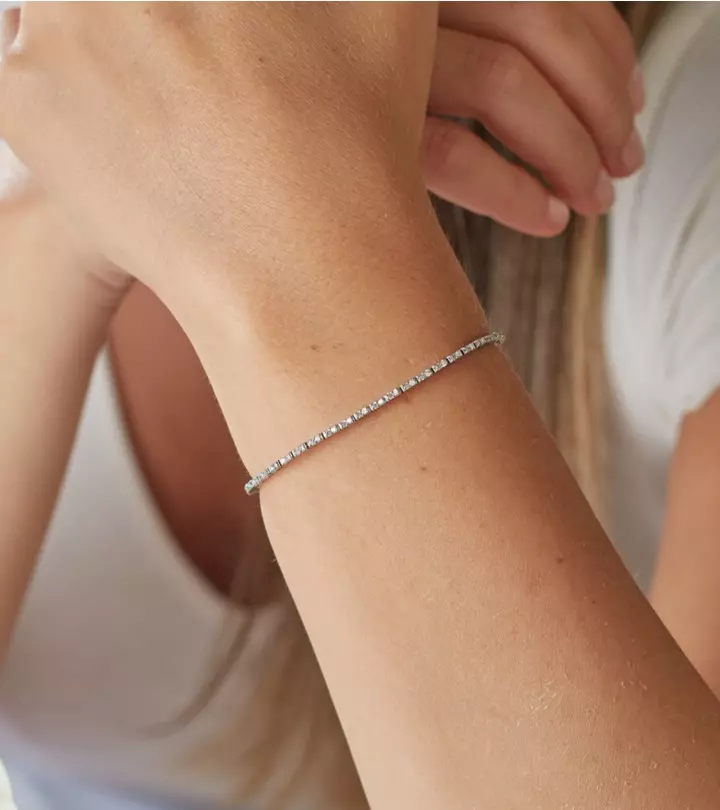
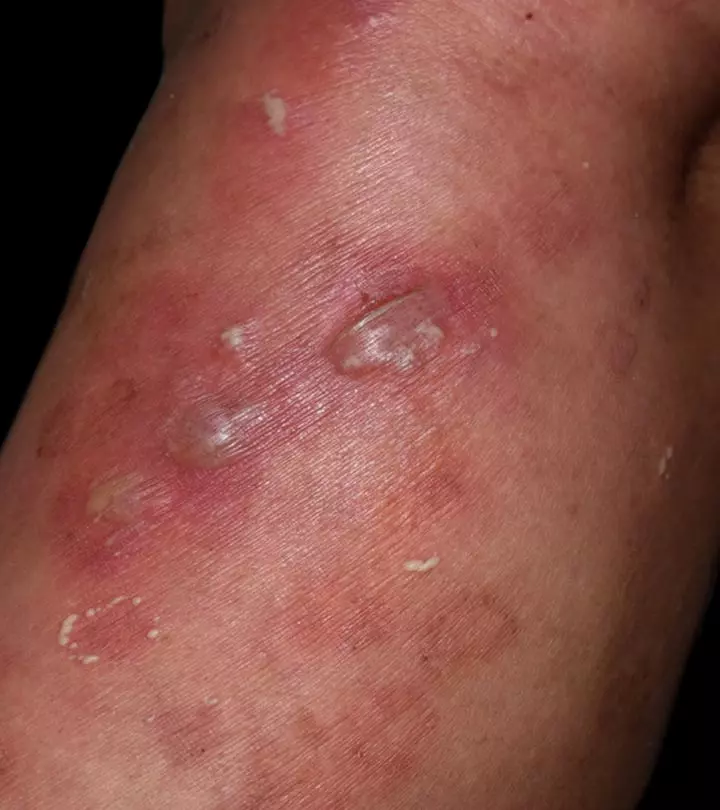
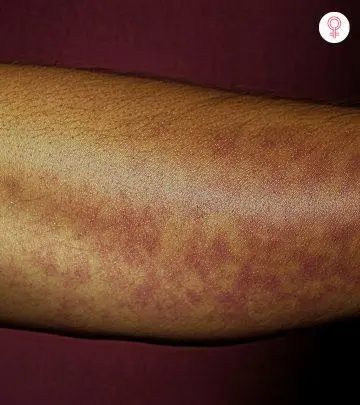
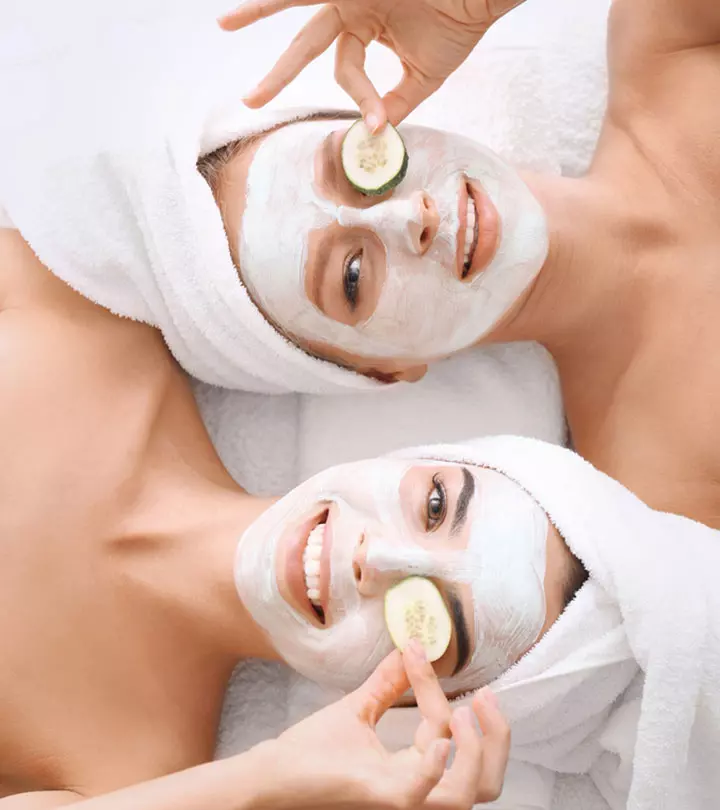

Community Experiences
Join the conversation and become a part of our empowering community! Share your stories, experiences, and insights to connect with other beauty, lifestyle, and health enthusiasts.